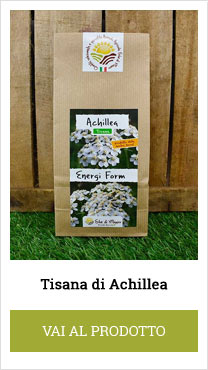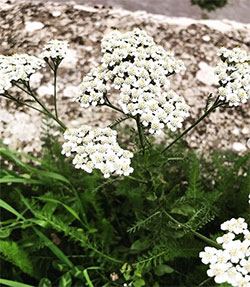
Yarrow ( Achillea millefolium ) is a medicinal plant with a long tradition. Already in Greek mythology, the soldier Achilles is said to have healed more and more war wounds with the use of yarrow.
The yarrow owes its Latin name Achillea millefolium to its use in the healing of Achilles’ wounds, and to its thousand-fold branching leaves.
But “soldier’s weed” wasn’t just used to heal war wounds. For centuries, folk medicine has made extensive use of yarrow for the treatment of typical women’s ailments, as well as for the treatment of gastrointestinal problems and as an appetite stimulant.
Properties and benefits of yarrow
The flowering tops of the Achillea are used, which contain active ingredients such as:
- Bitter substances., Which stimulate the appetite, stimulate digestion and bile;
- Tannins that have astringent and anti-inflammatory properties;
- The essential oil of chamazulene contained in yarrow is a germ inhibitor and prevents inflammation. Additionally, yarrow essential oils are said to have a calming effect;
- Flavonoids with antibacterial, anti-inflammatory and antispasmodic properties;
- Tannins with astringent properties.
Its field of application is quite diverse, as it enjoys ownership
- antispasmodic;
- digestive;
- hemostatic;
- anti-inflammatory.
The type of administration of yarrow can take the form of tea, tincture, compress, sitz bath or in tablet form, for example.
Applied externally , yarrow is used for
- Treatment of bleeding and infected wounds.
- Relief from the feeling of fullness and in chronic liver diseases with liver compresses with yarrow.
Taken internally, for example through herbal teas, or mother tincture, is useful in various cases:
- relieves menstrual pains and regulates menstrual flow;
- relieves abdominal cramps;
- promotes digestion and appetite;
- reduces bleeding, useful in bleeding hemorrhoids.
Uses in cosmetics
Yarrow herbal tea of beauty face packs, to eliminate impurities such as blackheads and excess sebum. It can also be used in the tub water to take a relaxing and purifying bath for the skin.
Use in the kitchen
Achillea has a slightly bitter taste and is usually unwelcome in the kitchen. It is however used in the preparation of a sauce to accompany fish or eggs.
Where does yarrow grow?
The yarrow is a plant that is easily found in the meadows of almost all of Italy. Its distribution area extends to Europe, North America and North Asia. It is an undemanding plant, which prefers sunny and dry places and is resistant to drought, heat and cold. The yarrow adapts to the most varied climatic conditions and can still be found even at altitudes above 3000 meters.
What parts of the plant are used for medicinal herbs?
Flowered tops are used. The harvest period is between June and September.
How to recognize the plant
The yarrow belongs to the Asteraceae family, the same as daisies. It forms a creeping and perennial rhizome. From it emerge the leaf rosette with pointed leaves from two to three pinnate and the annual stems, 20 to 80 cm high, rich in leaves. Both the leaves and the stem are softly hairy. At its end, the stem branches into one or more flower umbrellas, which are composed of small white to pink flower heads. The flowering period begins in May and ends in October. The fruit of the yarrow is small and inconspicuous.
Could it be interesting for you

NB : All information published on this site is informative and should not be considered as advice, or medical prescriptions, or other.

